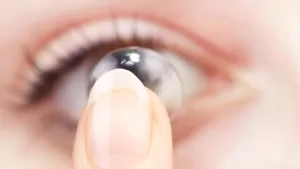
Role of Contact Lenses in Managing Various Eye Conditions
Contact lenses have been a popular vision correction option for many years, but they also play an important role in managing various eye conditions. Here, we will discuss the different eye conditions that can be managed with contact lenses, as well as the benefits and potential risks of using contact lenses for these conditions.
- Managing Myopia:
Myopia, also known as nearsightedness, is a common eye condition where distant objects appear blurry. Contact lenses can be an effective option for managing myopia, as they provide clearer vision without the inconvenience of wearing glasses. Contact lenses for myopia correction are available in soft, rigid, and hybrid materials, with various wearing schedules and replacement options.
- Managing Hyperopia:
Hyperopia, also known as farsightedness, is an eye condition where near objects appear blurry. Contact lenses can also be used to manage hyperopia, with a similar range of options as for myopia. Additionally, contact lenses can be used to correct presbyopia, a condition where the eyes lose the ability to focus on close objects as we age.
- Managing Astigmatism:
Astigmatism is a common eye condition where the cornea or lens is irregularly shaped, causing distorted or blurred vision. Specially designed contact lenses known as toric lenses are used in correcting astigmatism. These lenses have a specific orientation on the eye and are also available in soft, rigid, and hybrid materials, with various wearing schedules and replacement options.
- Managing Keratoconus:
Keratoconus is a condition where the cornea gradually thins and bulges into a cone shape, causing distorted and blurred vision. Contact lenses can be used to manage keratoconus by providing a smooth and regular surface for the cornea to focus light. Specially designed contact lenses, such as scleral lenses, can be used to provide a more comfortable and stable fit for people with keratoconus.
- Managing Dry Eye Syndrome:
Dry eye syndrome is a condition where the eyes do not produce enough tears or produce poor quality tears, causing dryness, irritation, and discomfort. Contact lenses can exacerbate dry eye symptoms, but some contact lenses are designed to help manage dry eye syndrome. These lenses can help retain moisture and lubrication on the eye’s surface, reducing the risk of dryness and irritation.
- Cosmetic and Prosthetic Contact lens:
Various colored contact lens are used for cosmetical purpose to enhance or alter the color of the eye. Also, Prosthetic contact lenses are prescribed to mask flaws and improve the appearance of an eye disfigured from a birth defect, trauma, or eye disease.
Benefits of Contact Lenses for Managing Eye Conditions:
- Clear and natural vision without glasses.
- Greater flexibility and convenience in daily activities, particularly for sports or other physical activities.
- Reduced distortion and better vision correction for certain eye conditions.
- Potentially better comfort and fit compared to glasses.
- Cosmetically better.
Risks of Contact Lenses for Managing Eye Conditions:
- While contact lenses can be an effective option for managing various eye conditions, there are also potential risks and drawbacks to consider, such as:
- Increased risk of eye infections and other complications, particularly with improper lens care or use.
- Potential discomfort or irritation from wearing contact lenses, particularly for people with dry eye syndrome or other eye conditions.
- Potential vision distortion or discomfort from improperly fitted lenses.
- Additional costs for purchasing and maintaining contact lenses.





